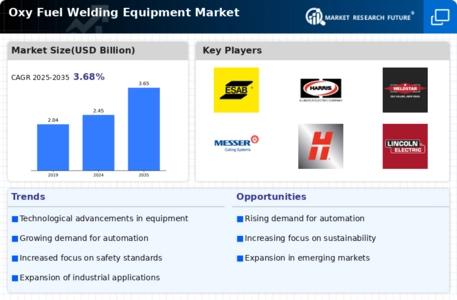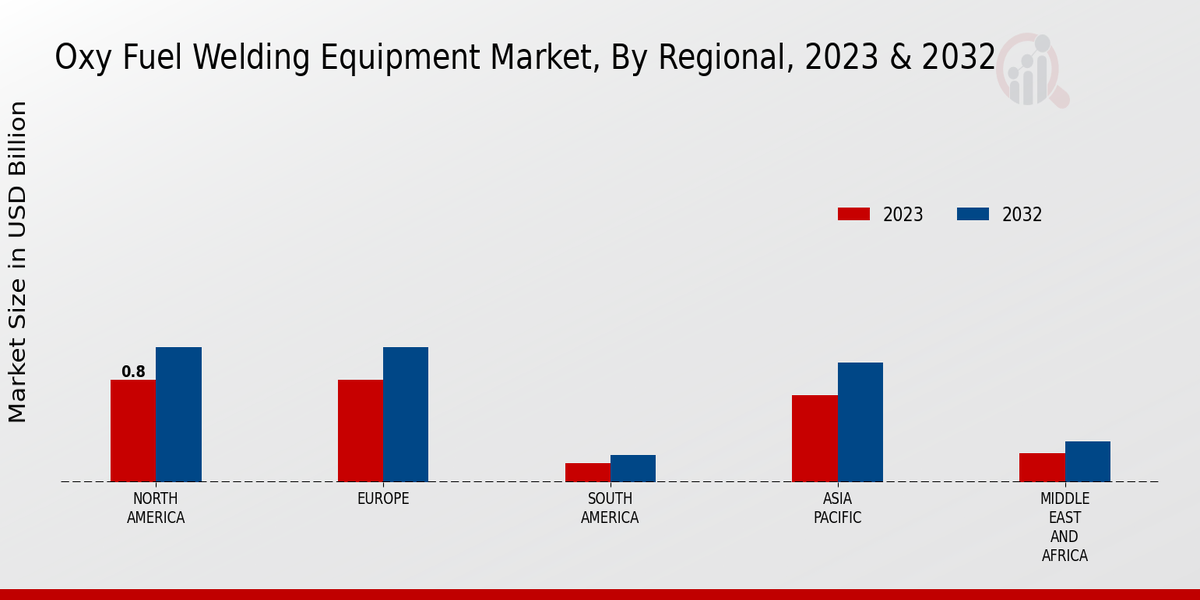Market Growth Projections
The Global Oxy Fuel Welding Equipment Market Industry is poised for substantial growth, with projections indicating a rise from 2.45 USD Billion in 2024 to 3.65 USD Billion by 2035. This growth trajectory suggests a compound annual growth rate (CAGR) of 3.69% from 2025 to 2035. Such figures reflect the increasing adoption of oxy fuel welding across various industries, driven by technological advancements and rising demand for efficient welding solutions. The market's expansion is likely to be influenced by factors such as infrastructure development, automotive sector growth, and environmental regulations, indicating a dynamic and evolving landscape.
Growing Demand for Metal Fabrication
The Global Oxy Fuel Welding Equipment Market Industry experiences a robust demand driven by the increasing need for metal fabrication across various sectors. Industries such as construction, automotive, and manufacturing are expanding, leading to a heightened requirement for efficient welding solutions. In 2024, the market is projected to reach 2.45 USD Billion, reflecting the industry's response to these demands. As companies seek to enhance productivity and reduce operational costs, oxy fuel welding equipment becomes a preferred choice due to its versatility and effectiveness in joining metals. This trend is likely to continue, with the market expected to grow at a CAGR of 3.69% from 2025 to 2035.
Rising Infrastructure Development Projects
Infrastructure development is a significant driver of the Global Oxy Fuel Welding Equipment Market Industry. Governments worldwide are investing heavily in infrastructure projects, including roads, bridges, and buildings, which require extensive welding applications. This surge in infrastructure spending creates a favorable environment for oxy fuel welding equipment, as it is essential for various construction processes. The market's growth is supported by the increasing number of public-private partnerships aimed at enhancing infrastructure. As these projects unfold, the demand for reliable and efficient welding solutions is likely to rise, contributing to the overall market expansion.
Technological Advancements in Welding Equipment
Technological innovations play a pivotal role in shaping the Global Oxy Fuel Welding Equipment Market Industry. The introduction of advanced welding technologies, such as automated oxy fuel systems and improved safety features, enhances operational efficiency and worker safety. These advancements not only streamline the welding process but also reduce the time and labor costs associated with metal joining. As industries increasingly adopt these technologies, the market is anticipated to grow, with projections indicating a rise to 3.65 USD Billion by 2035. The integration of smart technologies and IoT in welding equipment further indicates a shift towards more sophisticated solutions, appealing to modern manufacturing needs.
Environmental Regulations and Sustainability Initiatives
Environmental regulations and sustainability initiatives are increasingly shaping the Global Oxy Fuel Welding Equipment Market Industry. Stricter regulations regarding emissions and waste management compel manufacturers to adopt cleaner and more efficient welding technologies. Oxy fuel welding, known for its lower environmental impact compared to other welding methods, aligns with these sustainability goals. As industries prioritize eco-friendly practices, the demand for oxy fuel welding equipment is likely to rise. This shift not only supports compliance with regulations but also enhances corporate responsibility, positioning companies favorably in a competitive market.
Increasing Adoption of Oxy Fuel Welding in Automotive Sector
The automotive sector is witnessing a growing adoption of oxy fuel welding techniques, significantly impacting the Global Oxy Fuel Welding Equipment Market Industry. As manufacturers strive for lightweight and fuel-efficient vehicles, oxy fuel welding provides an effective solution for joining different materials. The automotive industry's shift towards electric vehicles also necessitates advanced welding techniques, further driving demand. With the market projected to reach 2.45 USD Billion in 2024, the automotive sector's influence is expected to propel growth. This trend indicates a broader acceptance of oxy fuel welding in various automotive applications, enhancing the overall market landscape.












